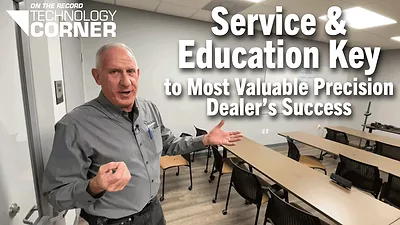In 2010, Steve Jobs, in his iconic black shirt and jeans, introduced the iPad. This was the device that he claimed would be bridging the gap between a computer and a phone. Its intuitive interface made it clear how capable it could be. Today, the iPad and similar tablets are everywhere, from businesses to entertaining toddlers at Applebee’s.
What is the agricultural equivalent of the iPad? One could argue that it could be rate controllers, farm management software, spot spraying technology, or satellite systems. However, specialty crop growers might shrug. Despite the progress that has been made, fewer technology advancements have been tailored to their needs. Precision Agriculture must evolve to address the unique challenges of specialty crops, requiring versatile, adaptable, and innovative equipment. We are starting to see manufacturers that excel in these traits, and mainstream crops will soon recognize the value of these innovations.
Calling them "specialty crops" also feels inaccurate. With such diversity, making up 40% of our cropping systems, they hardly seem "specialty." How good is a steak without a baked potato? A PBJ without grape jelly? Precision Agricultural production needs to embrace versatility, adaptability, and innovation, in the same way the iPad did for technology.
The Buying Power of Versatility
When Steve Jobs displayed the iPad, he showed its versatility by seamlessly switching from emails to buying tickets on Fandango. This reminds me of the ARA sprayer from Ecorobotix, which reduces manual weeding and lowers input costs in multiple high value crops like onions, lettuce, and carrots without changing the sprayer configuration. It uses high-speed HR cameras and advanced supercomputers to make real-time decisions in the field as to what is a weed versus crop.
Versatility is central to ARA’s design. Its algorithms adapt to various vegetables and weed pressures, addressing the diverse needs of specialty crops. Ecorobotix rapidly enhances its systems, moving from "problem statement" to standard operations in just 18 months. This means producers can receive help from a tool that works across multiple crops without needing to "trick" the software. Instead of tricking equipment, it creates opportunities to meet the demands of an ever-growing agronomic market in multitudes of fresh crops with a highly variable configuration.
The Art of Adaptability
The iPad immediately stood out with its intuitive user interface. During the 2010 stage show, Steve Jobs proved how simply turning the iPad had switched it from portrait to landscape mode, and how easily users could zoom in and out of content.
Adaptability is agriculture's biggest puzzle, especially with diverse crops like grapes, tomatoes, and onions, with highly variable row configurations, heights, and management techniques. This challenge demands adaptable sensors and programs.
WEED-IT exemplifies adaptability. Initially marketed for dryland spot spraying in wheat, it now has a growing list of applications. Due to its flexibility with sensor mounting orientation and row width has expanded its use to controlling shoots in berry and grape crops, under crop in orchards, and the growing use for between row weed control. With self-calibration and an active light source, WEED-IT performs well in the highly variable specialty crop environment, even with changing light and shade from trees. By focusing solely on weeds and minimizing environmental interference and allowing growers to decide how it is aligned on their equipment it delivers adaptable results.
The Innovation Revolution
It is amazing how easily our phones now use AI to tag and sort photos, a concept that seemed like science fiction in the 2010s. Steve Jobs demonstrated onstage the iPad's ability to sort photos by geotagging and facial recognition, paving the way for today's AI advancements.
Jobs foresaw a world where digital photography allowed us to search and use thousands of images. This need for innovative solutions to ever-changing problems, like herbicide limitations and weather changes, is driving agricultural innovation. Carbon Robotics exemplifies this with its LaserWeeders, which now work on over 100 different crops and every soil type, killing billions of weeds across not only multiple crop types but also multiple continents. These AI-powered tools target and destroy weeds with sub-millimeter accuracy using concentrated thermal energy.
Specialty crop growers, facing tight margins and rising labor costs, have quickly adopted this technology. It reduces the need for manual weeding and cuts chemical inputs, aligning with consumer preferences and regulatory trends. In 2025, Carbon Robotics introduced a driverless possibility, called Carbon AutoTractor, further enhancing efficiency and innovation in the high-demand world of specialty crops.
Where Do We Go from Here? Ask the Unlikely Hero
To drive innovation in cropping systems, we must embrace the challenges of crops that rarely buy technology. While the iPad now feels ancient, it was groundbreaking at the time. It was innovative because its closest peer, the palm pilot only focused on the business use case. The iPad looked at how could it make the work life and home life seamlessly integrate into the same device. Focusing solely on commodity crops might seem easier, but specialty growers, despite appearing behind and having less buying power, offer unique opportunities for innovation.
Collaborative research can lead to solutions that are widely adopted. Creating a farmer feedback loop involving diverse crops and perspectives can help develop user-friendly products. Designing flexible equipment that adapts to various climates and growing conditions can expand the client base and stabilize businesses economically.
To help growers, you need to ask growers. To bridge the computer and the phone, Apple had to look at what both solutions were missing.






